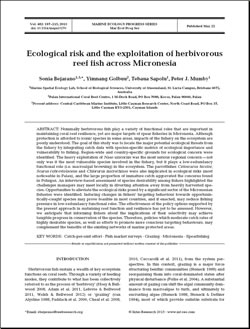Ecological Risk and the Exploitation of Herbivorous Reef Fish Across Micronesia
(2013)
Please find an excerpt of the full PDF below
 Nominally herbivorous reef fish play a variety of functional roles that are important in maintaining coral reef resilience, yet are major targets of spear fisheries in Micronesia. Although protection is afforded to iconic species in some areas, impacts of the fishery on the ecosystem are poorly understood. The goal of this study was to locate the major potential ecological threats to herbivorous reef fish from the fishery by integrating catch data with species-specific metrics of ecological importance and vulnerability to fishing. Region-wide and country-specific grounds for ecological concern were identified.
Nominally herbivorous reef fish play a variety of functional roles that are important in maintaining coral reef resilience, yet are major targets of spear fisheries in Micronesia. Although protection is afforded to iconic species in some areas, impacts of the fishery on the ecosystem are poorly understood. The goal of this study was to locate the major potential ecological threats to herbivorous reef fish from the fishery by integrating catch data with species-specific metrics of ecological importance and vulnerability to fishing. Region-wide and country-specific grounds for ecological concern were identified.
Ecological risk and the exploitation of herbivorous reef fish across Micronesia
Marine Ecology Progress Series
May 22, 2013
By Sonia Bejarano, Yimnang Golbuu, Tebaua Sapolu, Peter J. Mumby
The heavy exploitation of Naso unicornis was the most serious regional concern—not only was it the most vulnerable species involved in the fishery, but it plays a low-redundancy functional role (i.e. macroalgal browsing) in the ecosystem. The parrotfishes Cetoscarus bicolor, Scarus rubroviolaceus and Chlorurus microrhinos were also implicated in ecological risks (most noticeable in Palau), and the large proportion of immature catch aggravated the concerns found in Pohnpei.
An interview-based assessment of species desirability among fishers highlighted the challenges managers may meet locally in diverting attention away from heavily harvested species. Opportunities to alleviate the ecological risks posed by a significant sector of the Micronesian fisheries were identified. Inducing changes in fishers’ targeting behaviour towards opportunistically-caught species may prove feasible in most countries, and if enacted, may reduce fishing pressure in low-redundancy functional roles.
The effectiveness of the policy options supported by the present approach in sustaining reef function and resilience has yet to be assessed. However, we anticipate that informing fishers about the implications of their selectivity may achieve tangible progress in conservation of the species. Therefore, policies which moderate catch rates of highly desirable species, as well as efforts to promote more conscious targeting behaviours, may complement the benefits of the existing networks of marine protected areas.
INTRODUCTION
Herbivorous fish sustain a wealth of key ecosystem functions on coral reefs. Through a variety of feeding modes, they contribute to what has been collectively referred to as the process of ‘herbivory’ (Hoey & Bellwood 2008, Adam et al. 2011, Lefevre & Bellwood 2011, Welsh & Bellwood 2012) or ‘grazing’ (van Alystine 1988, Paddack et al. 2006, Cheal et al. 2008, 2010, Ceccarelli et al. 2011), from the system perspective. In this context, grazing is a major force structuring benthic communities (Steneck 1988) and reorganising them into coral-dominated states after physical disturbance (Folke et al. 2004). A substantial amount of gazing can shift the algal community dominance from macroalgae to turfs, and ultimately to encrusting algae (Steneck 1988, Steneck & Dethier 1994); most of which provide suitable substrata for settlement of coral larvae (Birkeland 1977, Harrington et al. 2004). In contrast, undergrazed reefs can become increasingly dominated by algal turfs or macroalgae (Hughes et al. 2007, Mum by & Steneck 2008, Diaz-Pulido et al. 2011), which can in turn reduce coral recruitment and recovery (Birrell et al. 2005, Hughes et al. 2007, Mumby et al. 2007).
With a few exceptions (e.g. Peyrot-Clausade et al. 2000, Mapstone et al. 2007), sea urchin populations account for modest contributions to grazing on Pacific reefs (Ogden 1987, Sammarco 1987), while herbivorous fish provide the foundation for the grazing process (Hoey & Bellwood 2008). Parrotfishes (formerly Scaridae, now reclassified as Labridae) (Westneat & Alfaro 2005), unicornfish and surgeon – fishes (Acanthuridae), and rabbitfishes (Si ga nidae) are the most common herbivores within Pacific fish communities (Russ 1984, Bellwood 1995, Jennings & Polunin 1996, Wantiez et al. 1997, Allen & Werner 2002). Feeding continuously throughout the day (Bellwood 1995), and over relatively large spatial scales (due to their roving behaviour), these families (hereafter referred to as roving herbivores) are capable of considerable grazing impact through a range of reef habitats (Fox & Bellwood 2007, Hoey & Bellwood 2008). Although collectively re ferred to as ‘herbivores’, these families encompass ~100 species with a variety of feeding modes (Choat et al. 2002, Fox et al. 2009, Hoey & Bell wood 2009, Marshell & Mumby 2012). Increasingly denominated ‘nominally herbivorous’, species are classified in 4 major functional groups, namely grazers/detritivo res, macro-algal browsers, scrapers/ small excavators, and large excavators/bioeroders (Green & Bellwood 2009). Not only do these functional groups affect different properties of the substratum, but they may also act complementarily in structuring benthic communities (Burkepile & Hay 2008) and promoting reef recovery after disturbance (Folke et al. 2004)…